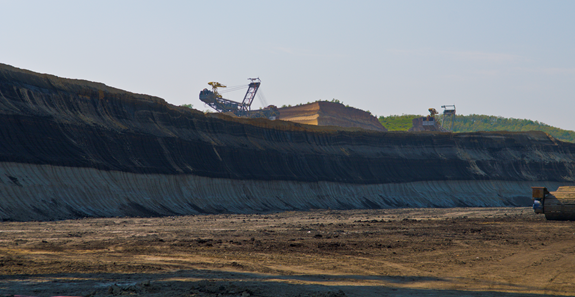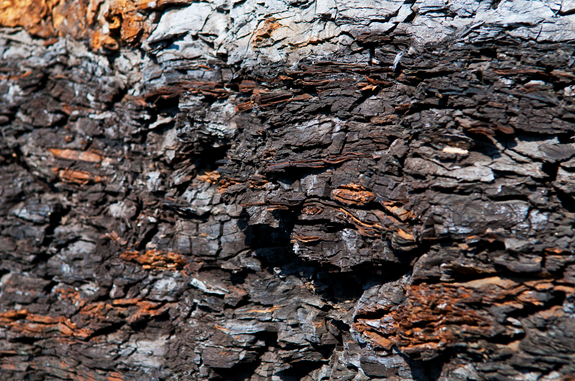- News
- Overview
- Research
- Multimedia
- Related Links
News
 |
Mercury is a toxic pollutant. In its elemental form, gaseous mercury has a long residence time in the atmosphere, up to a year, allowing it to be transported long distances from emission sources. Mercury can be emitted from natural sources such as... |
Tuesday, November 13, 2012 Type: Publication
|
 |
Electron beam microanalysis of coal samples in U.S. Geological Survey (USGS) labs confirms that As is the most abundant minor constituent in Fe disulfides in coal and that Se, Ni, and other minor constituents are present less commonly and at lower concentrations than those for As. |
Tuesday, May 01, 2012 Type: Outside Publication
|
 |
Dozens of natural and human-induced coal fires are active in the Powder River Basin (PRB) of southeast Montana and northeast Wyoming, the largest source of coal produced in the United States. Coal fires exhibit surface features similar to those found above high-temperature geothermal systems... |
Tuesday, March 06, 2012 Type: Outside Publication
|
 |
Coal fires occur in all coal-bearing regions of the world and number, conservatively, in the thousands. These fires emit a variety of compounds including greenhouse gases. However, the magnitude of the contribution of combustion gases from coal fires to the environment is highly uncertain... |
Tuesday, October 25, 2011 Type: Outside Publication
|
 |
Geochemistry is a constantly expanding science. More and more, scientists are employing geochemical tools to help answer questions about the Earth and earth system processes. Scientists may assume that the responsibility of examining and assessing the quality of the geochemical data they generate is... |
Tuesday, September 13, 2011 Type: Publication
|
 |
Increased demand for energy is driving rapid development of oil and gas, uranium, geothermal, wind, and solar sources of energy throughout the Western United States. Much of the energy development is occurring on public lands, which represents about 40 percent of Colorado and New Mexico... |
Monday, June 20, 2011 Type: Publication
|
 |
Within the United States (USA), a large group of people still use significant amounts of coal for home heating and some cooking. Among these are members of the Navajo Nation. Almost 175,000 people live within... |
Thursday, April 01, 2010 Type: Outside Publication
|
 |
Energy resources (coal, oil, and natural gas) are among the cornerstones of modern industrial society. The exploitation of these resources, however, is not without costs. Energy materials may contain harmful chemical substances that, if mobilized into air, water, or soil, can adversely impact... |
Friday, January 01, 2010 Type: Publication
|
Overview
Medical Geology is an emerging scientific discipline that examines the impacts that geologic materials and processes have on human and ecosystem health. Medical Geology:
- Identifies and characterizes natural and anthropogenic sources of harmful materials in the environment.
- Predicts the movement and alteration of chemical, infectious, and other disease-causing agents over time and space.
- Provides an understanding of how people are exposed to harmful materials and describes what can be done to minimize or prevent such exposure.
As the Nation's natural science agency, USGS can play a significant role in providing scientific knowledge and information that will improve our understanding of the environmental contributions to disease and human health.
Bill Orem
Project Chief
Research
Source Characterization
and Identification
Source Characterization and Identification of Natural and Anthropogenic Harmful Materials
Energy resources like coal, oil and natural gas are the pillars of our modern industrial society and they are the major catalyst for the fast paced technological advancement. However, their exploitation has side effects whose magnitude has triggered widespread concerns in the recent years, as the public has become more aware of the concept of global warming or... [+]
the increasing incidence of diseases like cancer or asthma. At the forefront of geomedical research, the USGS has the role to provide the public and the policymakers with the scientific information needed to account for the environmental and human health consequences of energy resource extraction, processing, transportation and use. The USGS is addressing these issues in an interdisciplinary context, through a dedicated project entitled “Impacts of Energy Resources on Human Health and Environmental Quality”. Several research topics include: Balkan Endemic Nephropathy (BEN), “panendemic nephropathy” (i.e., diseases similar to BEN but outside the Balkans), environmental contamination related to mountain top mining (MTM) and coal slurry in the Appalachian Basin and the release of toxic substances in energy combustion products.

Figure 1. Mountain top mining (MTM) in the
Appalachian Basin has adverse consequences
on the environment and human and ecosystems
health. USGS in collaboration with West Virginia
University in Morgantown is addressing issues
as water, air and soil pollution caused by MTM.
Enlarge Image

Figure 2. Coal, in native or processed form, is a
major source of organic pollutants that can leach
into groundwater or streams and affects humans
or aquatic organisms. This photo shows a seam
of Pliocene lignite from Romania; such low rank
coal deposits are widespread in the Balkan
endemic nephropathy (BEN) areas and are
supposed to contain nephrotoxic and
carcinogenic organic substances that
contaminate drinking groundwater and are
causing the fatal kidney disease and urinary
References:
Orem W., Tatu C., Pavlovic N., Bunnell J., Kolker A., Engle M. and Ben Stout (2009) Health Effects of Energy Resources. U.S. Geological Survey Fact Sheet 2009-3096.
Kolker A., Engle, M., Stracher G., Hower J., Prakash A., Radke L., ter Schure A., Heffern E (2009) Emissions from coal fires and their impact on the environment: U.S. Geological Survey Fact Sheet 2009-3084.
Orem W.H., Bunnell J.E. Tatu C.A., Pavlovic N., and (2009) Toxicological pathways of relevance to medical geology. In: Encyclopedia of Environmemntal Health (Nriagu J., editor), Elsevier Science 2011.
Contact: William H. Orem borem@usgs.gov
Movement and Alteration of
Disease-causing Agents
Movement and Alteration Predictions of Chemical, Infectious, and other Disease-causing Agents over Time and Space
Air can be a significant source of all sorts of human health hazards and compared to water and soil, transport of noxious chemicals and particulates or pathogenic microorganisms occurs much faster and can affect populational groups on a larger scale. USGS has been involved in several projects exploring the... [+]
links between human health and air quality alterations due to fossil fuel extraction/mining and combustion.
The presence in air of fine particulate matter 2.5 micrometers in size, called PM2.5, and originating from coal combustion and other sources, is a serious health concern. This material is small enough to be readily lodged in small interstices (alveoli) in the lungs. The U.S. Environmental Protection Agency (USEPA) air-quality regulatory standards are based on limits in the amount of PM2.5, while the USGS can provide more detailed knowledge on the chemistry, mineralogy, surface characteristics and potential toxicity of such particles.
A multi-agency study in the Navajo Nation of New Mexico has focused on the extent of human exposure to contaminants in particulate matter derived from domestic coal combustion and links to respiratory disease. The study was based on both epidemiological data examining the incidence of respiratory diseases as well as on field studies measuring indoor and outdoor air quality, including PM2.5. Air sampling in the Navajo Nation has shown that in winter, when coal stoves are in use, some homes exceed the USEPA 24-hour ambient (outdoor) PM2.5 standard. Analysis of PM2.5 samples from Navajo homes burning coal shows an abundance of organic compounds indicative of a coal source.
References:
Orem W., Tatu C., Pavlovic N., Bunnell J., Kolker A., Engle M. and Ben Stout (2009) Health Effects of Energy Resources. U.S. Geological Survey Fact Sheet 2009-3096.
Kolker A., Engle, M., Stracher G., Hower J., Prakash A., Radke L., ter Schure A., Heffern E (2009) Emissions from coal fires and their impact on the environment: U.S. Geological Survey Fact Sheet 2009-3084.
Bunnell J. E., Garcia L.V, Furst J.M., Lerch H., Olea R.A., Suitt S.E., and Kolker A. (2010) Navajo coal combustion and respiratory health near shiprock, new Mexico. J Environ Public Health. 2010:260525.
Contact: William H. Orem borem@usgs.gov
Harmful Material Exposure:
Analysis and Avoidance
Harmful Material Exposure: Analysis and Avoidance
The impact of environmental toxins on human health is of increasing public and scientific concern, and many human diseases of unknown etiology (including some types of cancer) may result from long-term, chronic exposure to toxic substances in the environment (air, water, soil). In order to understand the intricate links between contaminants from energy resources and human... [+]
disease, specialized facilities have been set up at the USGS, providing capability to perform toxicology experiments on human cell line cultures. These allow to study cellular alterations in response to toxicants and to establish toxic levels for certain energy resource-derived contaminants, through various techniques: toxicology bioassays, ELISA, molecular biology, microscopy, DNA sequencing and PCR. The results of such research are helpful in developing protocols to protect the public health through avoidance of exposure to potentially harmful substances, and to maintain environmental integrity and quality.

Figure 1. Spring used as drinking water supply
in a Balkan endemic nephropathy (BEN) village
in Bulgaria. Such water sources can be
contaminated with nephrotoxic/carcinogenic
compounds derived from low rank coal (Pliocene
lignite) and exposed human populations are at
risk of developing BEN and urothelial
carcinomas. Use of alternative water supplies
(deeper aquifers or municipal water from
outside the endemic area) has apparently been

Figure 2. Actin (green), a cytoskeletal protein, is
downregulated in HK-2 human kidney cell line
upon exposure to humic substances and other
organic compounds derived from coal. Such
immunofluorescence assays are useful in
investigating cellular alterations in the presence
of harmful compounds derived from energy
Contact: William H. Orem borem@usgs.gov
Page Last Modified: Friday, October 05, 2012
|
|
Human Health/Medical Geology Topics
Publication Search
A searchable database of thousands of published sources, dating back several decades
Find Data
USGS Energy Data Finder: Download GIS and tabular data, databases, geospatial web services (ArcGIS, WMS, KML)
EnergyVision
A single map viewer portal incorporating a range of maps, data and services
|